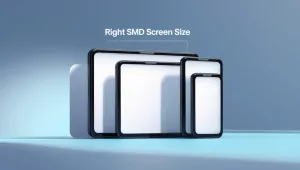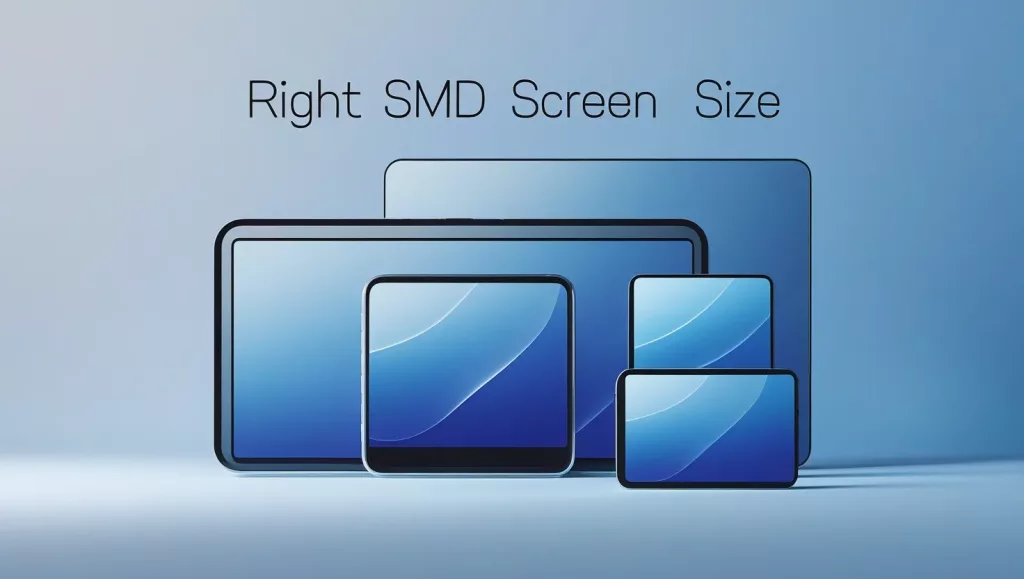How to Choose the Right SMD Screen Size for Your Business Needs

Introduction
Selecting the right SMD screen size for your business can significantly impact your overall visual presence, whether you’re setting up a display for a retail store, corporate event, or public installation. The size of your screen directly influences how well your audience can engage with your content. In this comprehensive commercial display guide, we’ll break down the key factors you need to consider when choosing LED screen sizes to ensure you make the best decision for your specific business needs.
Understanding SMD Screen Sizes
Before diving into the selection process, it’s important to understand what SMD screen sizes entail. SMD (Surface-Mount Device) screens come in various sizes, often defined by their pixel pitch—the distance between individual LED pixels. The size and pixel pitch of the screen work together to determine the display’s clarity, with smaller pixel pitches resulting in sharper images, especially for up-close viewing.
Larger screens with wider pixel pitches are ideal for viewing from a distance, while smaller screens with tight pixel pitch work best for closer, detailed viewing environments.
1. Define Your Business Goals and Needs
The first step in selecting the right SMD screen size is to clearly define your business goals. What do you want to achieve with the screen? Are you using it for branding, advertising, or interactive presentations? Understanding your specific objectives will guide you in selecting the most suitable screen size.
For example, retail stores may opt for larger screens to grab customer attention with promotional content, while corporate environments might prefer smaller, high-resolution displays for presentations and internal communications.
2. Consider Viewing Distance and Audience Size
One of the most critical factors in choosing SMD screen sizes is the distance between your screen and the audience. Larger audiences and bigger spaces often require larger screens to ensure visibility from the back of the room. On the other hand, smaller settings, such as a corporate lobby or retail kiosk, can make use of smaller, high-resolution displays.
A general rule of thumb is that the further away your audience is, the larger the screen should be to ensure clear visibility of the content.
3. Indoor vs. Outdoor Display Considerations
When selecting the right SMD screen size, consider whether your screen will be used indoors or outdoors. Outdoor SMD screens typically require larger sizes to compete with ambient lighting conditions, including sunlight, which can reduce visibility. Indoor screens can be smaller since lighting conditions are more controlled.
Outdoor commercial display setups often prioritize size and brightness to ensure the content stands out, while indoor displays focus more on resolution and detailed visuals.
4. Space and Placement in Your Business Environment
The size of your screen needs to fit comfortably within the space where it will be installed. Whether it’s a retail shop, conference room, or outdoor advertising space, the screen size should complement the environment without overwhelming it. Measure the space carefully to ensure your chosen screen size integrates well into the surrounding area and is placed strategically to maximize impact.
Also, consider height placement: placing your screen too high or too low can affect visibility and engagement.
5. Importance of Resolution in Screen Size Selection
When choosing LED screen sizes, it’s important to balance size with resolution. A larger screen doesn’t automatically mean better quality. For example, a large screen with a low resolution can appear pixelated, especially at close viewing distances. In contrast, a smaller screen with high resolution provides sharper and more detailed images. For close-up applications, such as digital kiosks, resolution should be a priority when determining screen size.
6. Flexibility in Screen Configuration
One advantage of modern SMD screens is their flexibility in configuration. You can create modular video walls by combining multiple screens, allowing you to customize the size and shape of the display to fit your specific needs. This flexibility is particularly useful for businesses that plan to scale their displays over time or use the same screens for multiple events.
Modular designs offer versatility, allowing businesses to reconfigure the display setup as needed, whether for small indoor spaces or large public events.
7. Budget Considerations When Choosing SMD Screen Sizes
Budget plays a significant role in determining the right SMD screen size for your business. Larger screens generally come with higher costs, but this investment often translates into a greater visual impact. Smaller businesses or those with limited budgets can opt for smaller screens with high resolution to ensure quality content delivery without overspending.
It’s essential to balance your budget with your business needs to find the most cost-effective screen size without sacrificing quality.
8. Energy Efficiency and Screen Size
Another factor to consider is the energy consumption of larger SMD screens. While bigger screens can draw more attention, they also tend to consume more power. If energy efficiency is a priority for your business, especially for long-term installations, consider screens that offer high brightness and clarity with lower energy consumption.
Finding the right balance between screen size and energy usage can help you manage operational costs while delivering impactful visuals.
Applications of SMD Screens Across Industries
SMD screens are highly versatile and can be applied across various industries:
- Retail and Commercial Advertising: Larger screens in high-traffic areas can boost visibility for products and promotions.
- Corporate Offices and Conference Rooms: Smaller, high-resolution screens are ideal for presentations and digital signage in corporate settings.
- Event Spaces and Public Installations: Modular screens allow for flexible configurations at trade shows, exhibitions, and outdoor events.
SMDLED: Your Trusted Partner for SMD Screen Solutions
Looking for the perfect SMD screen for your business? SMDLED provides a wide range of SMD screens that cater to businesses of all sizes across Pakistan. Whether you’re located in Karachi, Lahore, Islamabad, or Multan, SMDLED delivers high-quality commercial displays to fit any application. Their partnership with Bia SMD ensures top-of-the-line products built to meet your specific needs. Let SMDLED help you find the right screen size that fits both your goals and budget.
Best Practices for Installing the Right SMD Screen Size
Once you’ve selected the right SMD screen size, ensure it’s installed properly to maximize its impact. Professional installation will help guarantee that the screen is mounted securely, connected correctly, and configured for optimal performance. Additionally, calibrating the screen based on its size and placement will ensure the best possible viewing experience.
Future Trends in SMD Screen Sizes
Looking ahead, the future of SMD screen sizes continues to evolve, with advancements in resolution, energy efficiency, and modular designs. These trends will give businesses even more flexibility in choosing the ideal screen size for their needs. As technology advances, screens will become thinner, lighter, and even more visually striking, allowing for innovative new applications.
Conclusion
Choosing the right SMD screen size for your business is a key decision that can enhance your brand’s visibility and engagement. By considering factors like viewing distance, resolution, space, and budget, you can find the perfect size that meets your business objectives. With the right guidance and products from a trusted provider like SMDLED, your business can make a lasting impact with high-quality, visually stunning displays.
FAQs
- How do I calculate the ideal screen size for my space?
- Measure the distance between the screen and the audience, then choose a size that ensures clear visibility from the farthest point.
- What is pixel pitch, and why is it important for screen size?
- Pixel pitch refers to the distance between LED pixels. Smaller pixel pitch means sharper images, which is crucial for close-up displays.
- Can SMD screens be resized or reconfigured later?
- Yes, modular SMD screens allow for resizing and reconfiguration based on future needs or space changes.
- How does the location (indoor vs. outdoor) affect screen size choice?
- Outdoor screens generally need to be larger and brighter to combat ambient light, while indoor screens can be smaller with higher resolution.
- What are the most cost-effective SMD screen sizes for small businesses?
- Smaller, high-resolution screens provide excellent visibility without exceeding budget constraints, making them ideal for small businesses.
Looking for premium SMD screens and professional display solutions? SMDLED.PK is your trusted partner for state-of-the-art SMD technology. Explore our top-quality products like the stunning Leyard HDR 4K SMD Video Wall for crystal-clear visuals, the versatile MSA Plus SMD LED Screen Module, the sleek MSA Ultra Thin SMD LED Screen Module for modern setups, the durable MSG Outdoor SMD LED Screen Module, and the efficient MSG Indoor SMD LED Screen Module perfect for indoor environments.
We also offer exceptional Outdoor SMD Screens, Indoor SMD Screens, Flexible SMD Screens for creative designs, Cabinet SMD Screens for secure setups, Signpole SMD Screens for advertising, and stunning SMD Video Walls for large-scale visual impact. With SMDLED.PK, experience reliability, superior technology, and tailored solutions for all your display needs. Visit us today and transform your spaces with unparalleled visual excellence!

